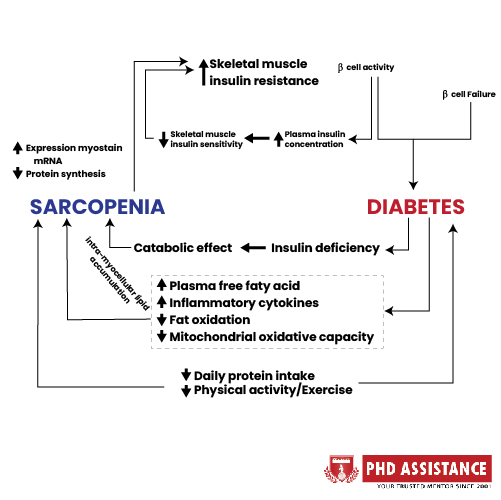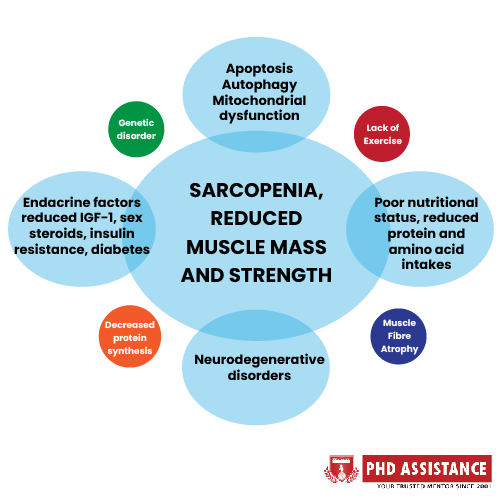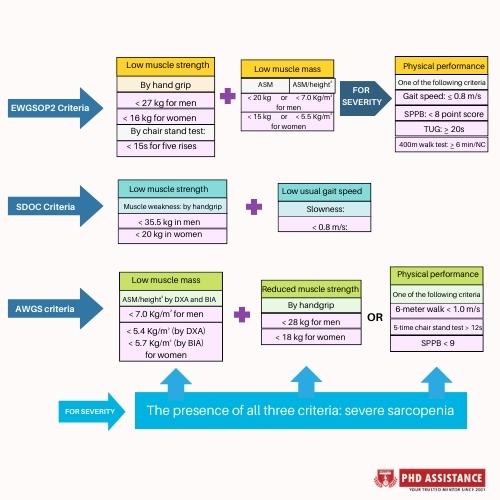PhD research directions for 2022 in Nutritional Aspects of Sarcopenia in Diabetes
About 25% of adults over 65 have type 2 diabetes mellitus (T2DM), a significant health burden for the senior population. With the population’s increased lifespan shown in recent years, this proportion is anticipated to rise sharply during the following decades. The purpose of this blog post is to offer an update on (1) the risk of Sarcopenia in people with type 2 diabetes; and (2) its correlation with important characteristics of patients with type 2 diabetes.
Sarcopenia and Diabetes: Basic Information
After the age of 40, Sarcopenia is characterized as a widespread loss of muscle mass that is progressive and occurs at a rate of 8 % each decade up to the age of 70 and 15 to 25 % subsequently. It’s important to remember that according to research, the prevalence of Sarcopenia varies between 10 and 40 %, depending on the demographic and the criteria employed to diagnose it. In reality, in addition to the previously well-known consequences of T2DM, including micro and macrovascular disorders, Sarcopenia and frailty are generally becoming more well recognized.

Figure: 1 The interaction between Sarcopenia and diabetes
Sarcopenia and Diabetes Nutritional Aspects: Key Ideas
With a particular focus on ageing, overweight/obesity, sex, the duration of T2DM, the use of antidiabetic medications, the presence of T2DM complications, and nutritional status, the Nutritional Aspects section of this article has provided an overview of the relationship between Sarcopenia and several features of T2DM. To offer an update on the most PhD research current results in this field and to review the key dietary factors that are relevant in the presence of Sarcopenia and T2DM.
According to the review, T2DM participants with and without Sarcopenia have no changes in the prevalence of alcohol intake. Regular coffee consumption has been linked to a preventive effect against the onset of Sarcopenia, perhaps as a result of the anti-inflammatory and antioxidant qualities of coffee. On the other hand, drinking coffee appears to be linked to a reduced incidence of T2DM. Those who have Sarcopenia may also benefit from drinking tea; in particular, green tea polyphenols and Catechins have been proven to have antioxidant properties.

Figure: 2 Nutritional intervention
Relationship between Nutrition, Sarcopenia and Diabetes
In addition to the lifestyle diseases and nutritional state of both middle-aged and older adults with Sarcopenia and T2DM, the association between malnutrition and Sarcopenia includes several metabolic characteristics (including indices of glucose metabolism). The subjects with probable Sarcopenia were older, had lower waist-to-hip ratios and BMIs, longer diabetes duration, higher fasting plasma glucose levels and glycosylated haemoglobin, decreased estimated glomerular filtration rates, lower bone mineral contents, and lower fatless upper arm circumference, appendicular skeletal muscle mass index, and muscle quality.
According to suitable research topics in diabetes and nutrition guidance, each participant kept a diet journal for three days straight, recording the weight of each meal type. The total daily energy, carbohydrate, protein, and fat consumption and the percentage of calories provided by each of the three macronutrients were then calculated, with appropriate modifications for body weight.

Table- 1: The presence of three criteria: severe Sarcopenia
Sarcopenia in Individuals with Type 2 Diabetes Mellitus: Associated Factors
- Age
According to several reports, Sarcopenia and age have been linked in a major way in T2DM patients. According to most research, people with T2DM with Sarcopenia are typically older than those without Sarcopenia: 73.6 years and 67.2 years, respectively.
- Gender
Studies have found different effects of gender on the occurrence of Sarcopenia, and the findings are not conclusive. Several research showed that Sarcopenia was considerably more common in males than women. However, the gender distribution of PhD diabetes and T2DM with Sarcopenia was not different, according to other research.
- Body Mass Index
According to several studies, the prevalence of Sarcopenia dramatically reduces when BMI rises, and BMI is much lower in T2DM patients with Sarcopenia than in those without it. According to this research, Sarcopenia is related to a low BMI and a high body fat percentage in people with type 2 diabetes.
- Diabetes Duration
The statistics are not conclusive when looking at T2DM duration. According to several research, the prevalence of Sarcopenia increases with the length of diabetes. For instance, when participants were divided into groups based on how long they had diabetes symptoms, the majority of Sarcopenia was 27.6%, 21.8%, and 52.6%, respectively, in the groups with diabetes duration of less than 10, between 10 and 20, and over 20 years.
- Nutritional Status and Lifestyle
In epidemiological research, it has not been discovered that Sarcopenia in people with TD2M is connected with glucose management, which is primarily assessed by testing glycated haemoglobin (HbA1c).
- Glucose-Lowering Drugs
Except for biguanides, which were used less often in patients with Sarcopenia, glucose-lowering medications did not differ substantially between individuals with and without Sarcopenia overall.
Conclusion
The research that is now available is quite consistent in demonstrating that Sarcopenia is more common in T2DM patients. Various processes might explain this connection, including decreased insulin sensitivity, long-term hyperglycemia, AGEs, subclinical inflammation, and micro-and macrovascular problems. However, only older age and a low body mass index are significant risk factors for Sarcopenia in T2DM. However, glucose management and diabetes research duration are not powerful influences. Information on other T2DM traits related to this illness is conflicting. However, adopting changes to one’s lifestyle that have been proven successful in the past would be a more efficient—though by no means simple—way to lessen the prevalence and severity of Sarcopenia in the senior population.
About PhD assistance
PhD assistance could be advantageous for you in drafting a standards-compliant PhD research proposal. A crucial step in the PhD application process is writing a research proposal, which universities use to assess your suitability for their research program. Several international schools have used the research proposal to decide whether or not to accept admission offers into the DBA/Doctoral program. The study proposal should be written to give readers a positive impression of your research abilities.
References
- Izzo, Anna, et al. “A narrative review on sarcopenia in type 2 diabetes mellitus: prevalence and associated factors.” Nutrients1 (2021): 183.
- Göbl, Christian, and Andrea Tura. “Focus on Nutritional Aspects of Sarcopenia in Diabetes: Current Evidence and Remarks for Future Research.” Nutrients2 (2022): 312.



